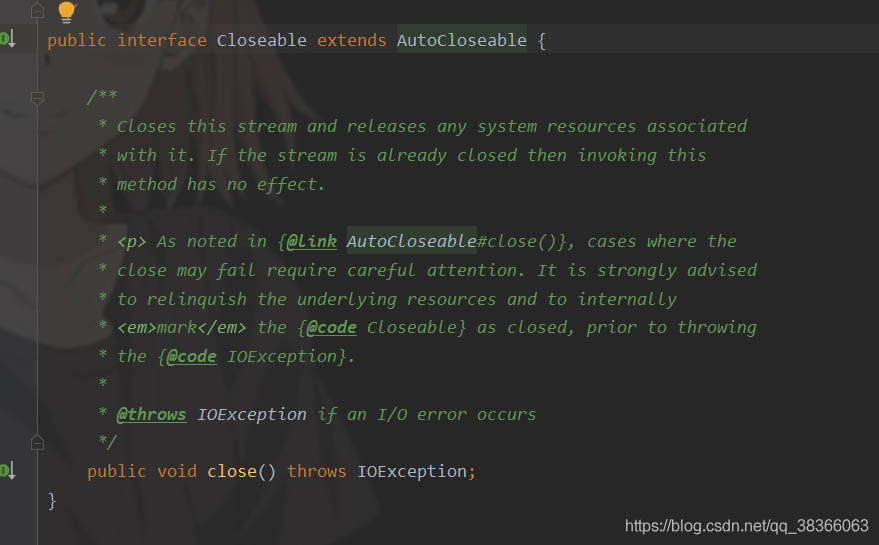带参数的try(){}语法含义
带资源的try语句(try-with-resource)
最简形式为
|
1
2
3
4
|
try(Resource res = xxx)//可指定多个资源
{
work with res
}
|
try块退出时,会自动调用res.close()方法,关闭资源。
PS:在coreJava第9版的第一卷的486页有解释。
挺好用的语法,不用写一大堆finally来关闭资源,所有实现Closeable的类声明都可以写在里面,最常见于流操作,socket操作,新版的httpclient也可以;
需要注意的是
try()的括号中可以写多行声明,每个声明的变量类型都必须是Closeable的子类,用分号隔开。楼上说不能关两个流的落伍了
补充一下:在没有这个语法之前,流操作一般是这样写的:
|
1
2
3
4
5
6
7
8
9
10
11
12
13
14
15
16
17
18
|
InputStream is = null;
OutputStream os = null;
try {
//...
} catch (IOException e) {
//...
}finally{
try {
if(os!=null){
os.close();
}
if(is!=null){
is.close();
}
} catch (IOException e2) {
//...
}
}
|
而现在你可以这样写:
|
1
2
3
4
5
6
7
8
|
try(
InputStream is = new FileInputStream("...");
OutputStream os = new FileOutputStream("...");
){
//...
}catch (IOException e) {
//...
}
|
生活一下就美好了
对try(){}的简单理解
以前使用try catch-finally都是捕获异常,然后流关闭等等,代码总是这样的:
好比往FileOutputStream写东西
|
1
2
3
4
5
6
7
8
9
10
11
12
13
14
15
16
17
|
@Test
public void test2() throws IOException {
File file = new File("E://test");
if (!file.exists()) {
file.createNewFile();
}
FileOutputStream fileOutputStream = new FileOutputStream(file);
try {
System.out.println("do something...");
fileOutputStream.write("aaa".getBytes());
fileOutputStream.flush();
} catch (Exception e) {
System.out.println("do ...");
} finally {
fileOutputStream.close();
}
}
|
这样写很难受,可以进行优化
将FileOutputStream fileOutputStream = new FileOutputStream(file)放到try()里面,也可以放多个
|
1
2
3
4
5
6
7
8
9
10
11
12
13
14
15
|
@Test
public void test2() throws IOException {
File file = new File("E://test");
if (!file.exists()) {
file.createNewFile();
}
try( FileOutputStream fileOutputStream = new FileOutputStream(file);) {
System.out.println("do something...");
fileOutputStream.write("aaa".getBytes());
fileOutputStream.flush();
} catch (Exception e) {
System.out.println("do ...");
}
}
|
try()里每个声明的变量类型都必须是Closeable的子类,就一个close方法
相当于系统自动将关闭操作放到了finally里面而不需要我们自己写了,很nice

|